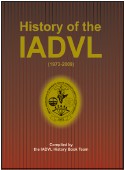Translate this page into:
History of the IADVL (1973-2009) compiled by the IADVL History Book Team (Edited by Dr. Uday Khopkar and Dr. DM Thappa)
Correspondence Address:
Terence J Ryan
(Emeritus Professor both at Oxford and Oxford Brooks University, UK), Brook House, Brook Street, Great Bedwyn Marlborough, Wiltshire, SN 8 3LZ
United Kingdom
| How to cite this article: Ryan TJ. History of the IADVL (1973-2009) compiled by the IADVL History Book Team (Edited by Dr. Uday Khopkar and Dr. DM Thappa). Indian J Dermatol Venereol Leprol 2010;76:726-727 |
 Publisher: Medknow Publications and Media Pvt. Ltd. 2009
Publisher: Medknow Publications and Media Pvt. Ltd. 2009
Pages: 216, Price: Free to members of IADVL
The Indian Association of Dermatologists, Venereologists and Leprologists (IADVL) has made an important contribution to record the history of dermatology. It is a great team effort and a review should acknowledge all those who have worked so hard to collect so much information and should not fail to draw attention to the subject matter of its 37 chapters. The reviewer is choosing an easy way out by reproducing the Editors′ summary entitled "About this book."
"The idea to prepare and publish this book was put forward by our Past President Dr. S Sacchidanand during his tenure. The idea was immediately supported and painstakingly pursued to its conclusion by Dr. Suresh Joshipura. An IADVL History Book Team was formed and headed by both of them as Project Directors and Dr. Uday Khopkar and Dr. Devinder M Thappa as the editors. However, the engines to this project were the Honorary Secretaries, past (Dr. Koushik Lahiri) and present (Dr. Rajeev Sharma)."
"The book briefly deals with the development of our speciality and describes how the stage was set for formation of the Indian Association of Dermatologists and Venereologists, which was, in a way, a precursor of the now well developed IADVL. A detailed account of the events leading to actual formation of the IADVL is given in the chapter authored by Dr. Devinder Mohan Thappa and Dr. Gurmohan Singh. Other chapters detail developments with regards to the IADVL constitution, IADVL logo, IADVL Conferences, IADVL Awards and Medals and the Indian Journal of Dermatology, Venereology and Leprology (IJDVL). Relations of IADVL with the South Asian Region Association of Dermatologists (SARAD) and those with other International Societies are described in separate chapters. Individual State Branches have given a description of their activities in the section History of the IADVL State Branches. The book is amply illustrated by the History Book Team Members. Dr. Lahiri and Dr. Joshipura have added flair to the book with their collection of souvenirs of IADVL conferences, badges of conferences and signatures of IADVL office bearers."
The editors then go on to describe the way in which they recruited many helpers, and how chapters were written and revised on the Web. Many senior members helped at all stages with coordination and much correspondence led by Dr. Rajeev Sharma, and sanctioning funds and pushing the project to completion before the Annual Meeting in 2010 were done by Dr. VK Sharma, President, IADVL.
India, with its more than a billion population and host to so many skin diseases, including neglected tropical diseases, needs the IADVL to be an effective organization. It became effective only recently and this book in 2010 is one of the achievements of recent years to be added to the improved journals, well-organized and instructive annual national meetings, textbooks of improved quality, and active participation in International affairs. The early history records a strong British role and an important role of leadership played by the Indian Army Medical Services. But there were also, half a century ago, some strong contributions from a few individuals who were familiar figures as hosts and writers, such as Dr. Banerjee in Calcutta, Dr. Desai in Bombay, Dr. Khandari and Dr. Behl in Delhi, and the still contributing Dr. Gurmohan Singh of Varanasi and Dr. Verma of Baroda, and also some from London and Philadelphia. Many of these persons also have contemporary family members whose names can be recognized as leading teachers in the field.
All those who worked on this initiative are to be congratulated for bringing out such an important book "History of Dermatology in India" to which more information on the history of Venereology and Leprosy will be added soon.
Fulltext Views
2,004
PDF downloads
2,480





